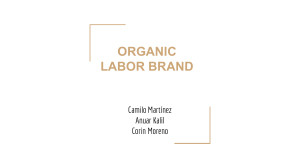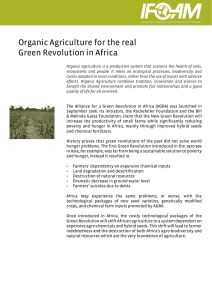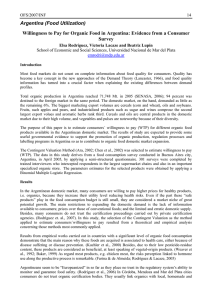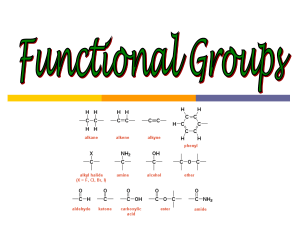Consumer`s preferences for organic food in Argentina
Anuncio
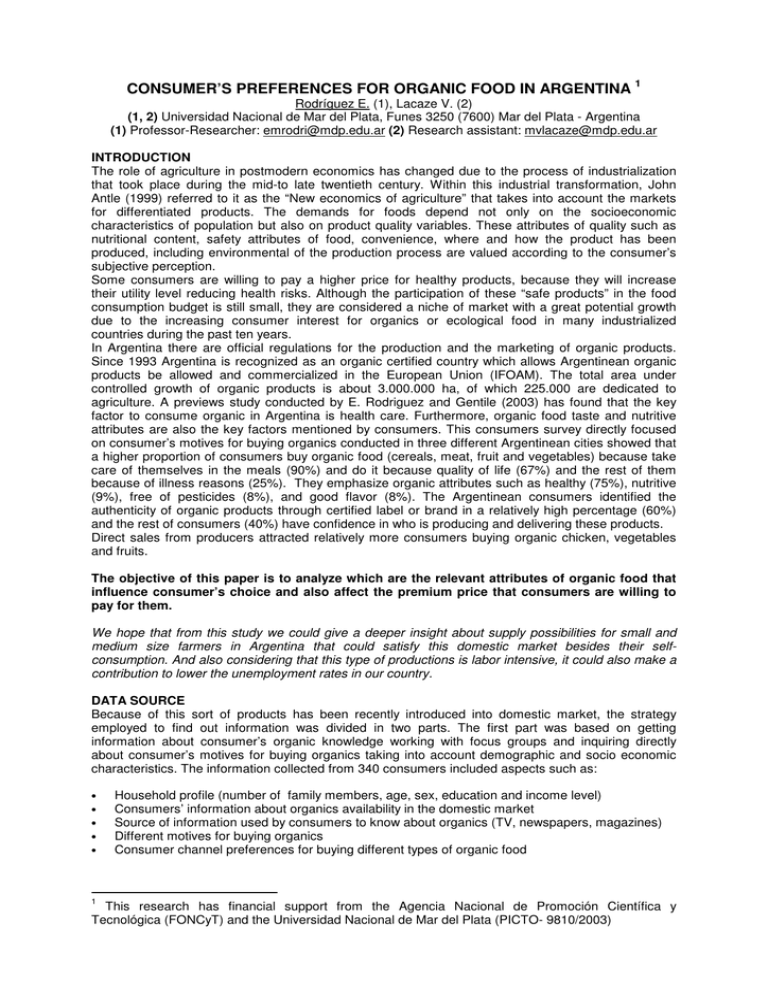
CONSUMER’S PREFERENCES FOR ORGANIC FOOD IN ARGENTINA 1 Rodríguez E. (1), Lacaze V. (2) (1, 2) Universidad Nacional de Mar del Plata, Funes 3250 (7600) Mar del Plata - Argentina (1) Professor-Researcher: [email protected] (2) Research assistant: [email protected] INTRODUCTION The role of agriculture in postmodern economics has changed due to the process of industrialization that took place during the mid-to late twentieth century. Within this industrial transformation, John Antle (1999) referred to it as the “New economics of agriculture” that takes into account the markets for differentiated products. The demands for foods depend not only on the socioeconomic characteristics of population but also on product quality variables. These attributes of quality such as nutritional content, safety attributes of food, convenience, where and how the product has been produced, including environmental of the production process are valued according to the consumer’s subjective perception. Some consumers are willing to pay a higher price for healthy products, because they will increase their utility level reducing health risks. Although the participation of these “safe products” in the food consumption budget is still small, they are considered a niche of market with a great potential growth due to the increasing consumer interest for organics or ecological food in many industrialized countries during the past ten years. In Argentina there are official regulations for the production and the marketing of organic products. Since 1993 Argentina is recognized as an organic certified country which allows Argentinean organic products be allowed and commercialized in the European Union (IFOAM). The total area under controlled growth of organic products is about 3.000.000 ha, of which 225.000 are dedicated to agriculture. A previews study conducted by E. Rodriguez and Gentile (2003) has found that the key factor to consume organic in Argentina is health care. Furthermore, organic food taste and nutritive attributes are also the key factors mentioned by consumers. This consumers survey directly focused on consumer’s motives for buying organics conducted in three different Argentinean cities showed that a higher proportion of consumers buy organic food (cereals, meat, fruit and vegetables) because take care of themselves in the meals (90%) and do it because quality of life (67%) and the rest of them because of illness reasons (25%). They emphasize organic attributes such as healthy (75%), nutritive (9%), free of pesticides (8%), and good flavor (8%). The Argentinean consumers identified the authenticity of organic products through certified label or brand in a relatively high percentage (60%) and the rest of consumers (40%) have confidence in who is producing and delivering these products. Direct sales from producers attracted relatively more consumers buying organic chicken, vegetables and fruits. The objective of this paper is to analyze which are the relevant attributes of organic food that influence consumer’s choice and also affect the premium price that consumers are willing to pay for them. We hope that from this study we could give a deeper insight about supply possibilities for small and medium size farmers in Argentina that could satisfy this domestic market besides their selfconsumption. And also considering that this type of productions is labor intensive, it could also make a contribution to lower the unemployment rates in our country. DATA SOURCE Because of this sort of products has been recently introduced into domestic market, the strategy employed to find out information was divided in two parts. The first part was based on getting information about consumer’s organic knowledge working with focus groups and inquiring directly about consumer’s motives for buying organics taking into account demographic and socio economic characteristics. The information collected from 340 consumers included aspects such as: • • • • • 1 Household profile (number of family members, age, sex, education and income level) Consumers’ information about organics availability in the domestic market Source of information used by consumers to know about organics (TV, newspapers, magazines) Different motives for buying organics Consumer channel preferences for buying different types of organic food This research has financial support from the Agencia Nacional de Promoción Científica y Tecnológica (FONCyT) and the Universidad Nacional de Mar del Plata (PICTO- 9810/2003) • Groups of organic food consumed at home, their frequency of acquisition and the utilized purchase channel. These surveying methods were conducted in three different Argentinean cities: Buenos Aires, Mar del Plata and Córdoba during June/July of 2002 and 2003. These cities have been chosen because of their similar consumption patterns and also are near to production regions. METHODOLOGY Different methodologies such as focus groups and experimental methods for consumer’s surveys were used for getting information about organic consumer´s purchasing motives. A multinomial logit model was applied to estimate which are the subjective factors that determine the sale channels. This procedure selects those estimates that maximize the probability of buying for the channel options, considering supermarkets, direct sales and specialized stores. Working with focus groups in Mar del Plata and Mendoza we were able to evaluate the dimensions of recognition, attitude and confidence in the potential increase of organic consumption. The experimental methods were conducted to explore the reasons behind consumers´ choices, and to estimate the premium price that consumers are willing to pay for these products. A sensory evaluation method to detect sensorial differences between organic and conventional chicken attributes -odor, flavor, tenderness, juiciness and texture- was used in a pilot experiment with consumer panels (organic consumers and non-organic consumers) carried out in Mar del Plata, in July 2003. Tests of differences and the signed-rank test of Wilcoxon were applied to observe sensorial differences between the attributes (odor, flavor, tenderness, juiciness and texture) of organic chicken and a conventional one. RESULTS AND CONCLUSIONS The main conclusions using focus group are: • Consumers are worried about healthy and nutritive food, unsafety productive processes and health care. • Consumers associated organic products with the local production, homemade and handmade food. • The quality of the product is not associated to the packaging. • Consumers recognized the lack of credibility on the certification source, and scarce availability of organic food in the domestic market. Health care is the key factor to consume organics in the domestic market; the background reasons were quality of life, care in meals, and illnesses. Also taste and nutritive attributes were mentioned by consumers. The average age of person who decides the purchase is 49 years old, female (85%) and with a high formal education level. Applying the multinomial logit model for purchasing decisions it is remarkable that: • The principal sales channels selected by organic consumers are specialized stores, direct sales from farmers, and supermarkets. • Taking the supermarket as basis of comparison, the consumers who acquire more food have more opportunities to acquire them from the specialized shops. The previously mentioned results are relevant to the characteristics presented by each analyzed purchase channel for organic products. It is logical that the consumers whose diets are based on a wide range of organic food prefer the specialized shop, due to the fact that the offering variety of organic food is most. • On the other hand, after investigating the specialized shops’ sales and promotion strategies it has been concluded that these are much more aggressive, what results evident that specialized shops are the most utilized by the consumers who can or cannot identify the organic. It is also interesting to observe that among those who purchase this food from the supermarket are the consumers able to identify it and have relatively more opportunities to buy it there. • The Argentinean consumers identify the authenticity of organics through certified label or brand in a high percentage, but most of them also have confidence in producers and retailers. Direct sales from producers attracted relatively more consumers buying organic chicken, vegetables and fruits. Finally, the pilot experiment revealed that flavor and odor were the most emphasized attributes, and could be interpreted as the principal reasons explaining the choice of one of the tasted chicken samples. Odor 24% Flavor 38% Tenderness 19% Others 19% Figure 1: Reasons of tasted sample choice (% of total answers) Source: Author´s calculation Concerning flavor, the answers indicate that conventional chicken meat has turned out to be softer and less consistent than organic chicken. The organic chicken meat was revealed more consistent and fibrous than the conventional one. Those participants that chose the organic meat found the odor of conventional chicken disgusting. They also rejected its excessive content of water. In the other side, those who chose the conventional chicken did it because of the flavor and tenderness. They also found that the organic sample was more fibrous and less tender than conventional one. The next table shows the differences between both consumers panels: PANEL 1- Organic Food Consumers Chosen tasted sample 1st mentioned attribute Organic chicken Flavor Conventional chicken Flavor PANEL 2 - Organic Food non Consumers Chosen tasted sample 1st mentioned attribute Organic chicken Flavor Conventional chicken Tenderness Rejected sample/ because of Conventional chicken / Odor, water content Organic chicken / More fibrous Rejected sample/ because of Conventional chicken / Lack of meat consistency Organic chicken / More fibrous, less tender Table 1: Selected tasted sample Source: Author´s calculation The results from the sensorial tests to evaluate organic versus conventional chicken attributes reveled that the first one was considered relatively superior because of hormone-free attribute. The consumers´ buying choices depend on their education, information and socioeconomic level. When provided with information about organic chicken attributes to those consumers who hadn’t bought organics before (non-consumers), they were willing to pay an average premium price of 40% per kilogram to obtain a guarantee hormone-free chicken in the market. The analysis of this sensorial test information suggests that the choices done by consumers were not determined by the degree of previous knowledge on the existence of organic food. Nevertheless, it is possible to infer that other issues such as information, health concern, education and socioeconomic level of each one of the consumers, are playing a relevant role in affecting the desire of buying quality products. REFERENCES Antle J (1999). “The new Economics of agriculture”. American Journal of Agricultural Economics Proceedings, Vol 81, Issue 5. Bognar K “Modeling the taste of food. Tasting by computer”. [On line] [Browse: May 30 2003] http:// www.google.com Burton M, Rigby D et al. (2001) “Consumer Attitudes to Genetically Modified Organisms in Food in the UK. 71st EAAE Seminar _ The Food Consumer in the Early 21st Century. Zaragoza, Spain. Grunert, K. (2001) “Current Issues in the Analysis of Consumer Choice”. The MAPP Centre. The Aarhus School of Business, Denmark. Lacaze V, Rodríguez E (2004) “El rol de la degustación y la información en la elección de alimentos orgánicos”. In: Revista Nexos, Año 11 Nro 18, July 2004. ISSN 0328-5030. Rodríguez E, Gentile N (2003) “Organic food in Argentina: The domestic potential market”. Poster paper presented in the 25th International Conference of Agricultural Economists. Durban, South Africa, 16-22 August 2003. th Segger P. (1997) “World trade in Organic foods: A growing reality”. The 5 Conference on Trade in Organic Products. Oxford, England. September 1997. IFOAM International Senauer B. (2001) “The food consumer in the 21 Century. New Research Perspective”. European Association of Agricultural Economics. Zaragoza, Spain. April 2001. Yeung R, Mossir J. (2001) “Food safety risk: Consumer perception and purchase behavior”. British Food Journal, 103 (3). Verdume A, Gellynck X et al (2001). “Consumer’s acceptability of GM Food”. 71st EAAE Seminar. The Food Consumer in the Early 21st Century. Zaragoza, Spain.
